Table of contents
One could argue that minimum viable products (or "MVPs") are the most well-understood yet the most commonly misused tools in a digital entrepreneur's arsenal. Nearly everyone building a new product nowadays starts with an MVP. However, few have managed to master this tool and get the most out of it.
So, let me help you understand MVPs, how to build one properly, and how to tap into their full potential.
What is a Minimum Viable Product (MVP)?
If you ask this question to a group of entrepreneurs and product managers, most of them will answer that the minimum viable product is the version of the product that contains minimum functionality that is acceptable enough to release to the market.
And yeah, technically, they're correct. However, this definition is a little flawed, as it doesn't really describe the core purpose of the product development strategy. That is actually why many founders and product teams use MVPs the wrong way or label something an MVP that isn't really an MVP.
Some people think that the purpose of the MVP is to earn money early on. While that is possible, it is also perfectly fine for the MVP not to earn any revenue at all. So, if people don’t buy your MVP product, don't write it off just yet.
Others think that MVP is for building a customer base that will prove your product is working in the eyes of venture capitalists who want to invest in your product.
Again, you can do this, but it's not the purpose of an MVP.
So, what is an MVP?
While the concept of “starting small, checking if the idea is viable, then expanding” has existed for all recorded history, the formal (and my favorite) definition of MVP was developed by none other than the great Eric Ries. In his book The Lean Startup, Eric emphasizes testing your core hypotheses as the main purpose of an MVP.
In the Lean Startup Mindset, it doesn’t really matter what exactly the MVP looks like as long as:

To wit, real-world examples of MVPs are all around us—including ones that aren't even working products yet. For instance, the coupon management service Groupon launched its MVP as a tiny WordPress site that looked like this.
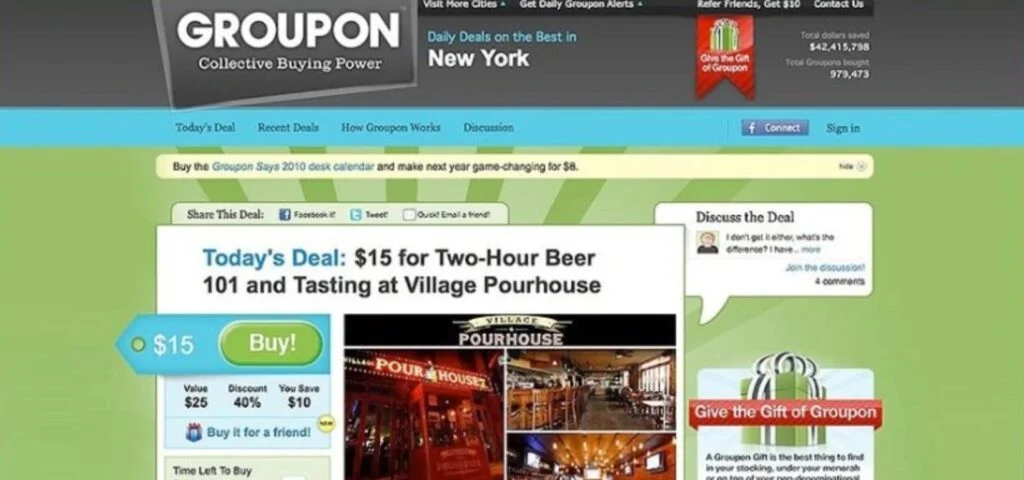
On this site, the Groupon team was simply sharing daily deals with their audience.
There are plenty of other examples of successful products, the MVP version of which was a landing page, social media group, and even a video demo of a non-existing product (more on that later).
Why startups need a Minimum Viable Product
There’s a good reason MVPs are so popular as a product development strategy among startup founders and product managers (despite many of them misinterpreting the concept). Building an MVP version lets early-stage startups avoid some of the biggest risks associated with startup life.
Let me highlight some of them and show how building an MVP helps mitigate them.
1. They prevent delayed launches
The digital world is as fast-paced as it can possibly be. Launching a product two quarters later than everyone else can mean losing out on market share to your competitors. Believe me, poaching users from someone else is much harder than getting a new user from the open market.
MVPs solve this problem by locking users to your platform early on. While you might not provide them with the end product they were dreaming about, a successful MVP (assuming it validates your core hypotheses) will keep users with you long enough for you to deliver the final product.
To understand just how much time an MVP can save, take a look at this chart, which I compiled using data from Atlassian, Shopify, and McKinsey.
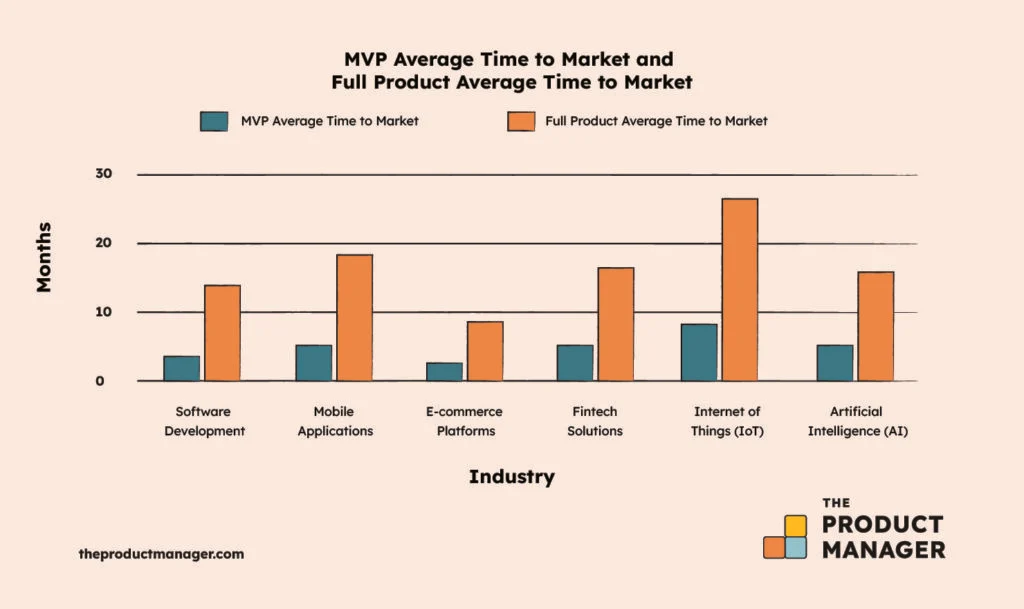
Depending on the type of product you build, you can save anywhere from nine months to two full years!
2. They minimize sunk costs
It’s absolutely fine for the first version of a new product you release to fail —
and frankly, it probably will.
In fact, the startup fail rate is so high (90%, according to a CB Insights report) that you should focus more on lowering the costs of these failures instead of hoping that your next product will be a massive success.
MVPs are one of the best tools to help you do exactly that. They help you validate the customer needs in the market against your value proposition with the least effort. This means you can test your business idea without going through the entire software development lifecycle with a prolonged development process. So, for the cost of making one complete product, you can make a dozen MVPs and check if they are lovable in the market.
3. They keep startups from "Blind-building" a product
I use the term "blind-building" to refer to the development of a product without much insight into what your intended users actually want. This is probably the single biggest sin that an entrepreneur can commit.
The problem with making a full product with all the new features on your roadmap and a ready-pricing strategy is that you have no idea if people will like it until you finish and release it.
Most of the time, people won’t like it, and you have to redo your prices and features. In some cases, you might even face the reality of entirely scrapping the product or fully changing the product pricing strategy.
The best way to avoid this is to get early feedback from users. How can you do it? With an MVP, of course!
How to build a Minimum Viable Product: Key steps
With the theory of MVPs behind us, let’s move on to the more practical parts and understand the steps needed to build an MVP concept that can properly serve its main purpose—letting you test your product viability in the market.
Step 1: Identify a problem to solve
Every great product starts with a user problem that needs to be solved. There are two substeps to this process:
a) Identifying the problem: This is what many startups do wrong — they identify the wrong problem.
For instance, in the early 1900s, the key problem in transportation was not a lack of faster horses or better infrastructure to let horses travel long distances. The real problem was that people needed a more reliable, heavy-duty means of transportation. Henry Ford successfully identified and solved this problem by introducing the car.
One of the best ways of identifying the right problem is the framework of Five Whys.
b) Understanding the problem: Finding the correct problem to solve is half the battle. The other half is about understanding the context and reality in which your users face that problem.
For example, the TikTok auto-generated subtitles resulted from the product team’s understanding that many users watch TikTok in environments where they have to mute the sound.
To do this, you will need to conduct user interviews. There’s no process more effective than talking to your users to understand their context.
Step 2: Define the Core Features of the MVP
Your typical product backlog will have more features than you need for your MVP.
To understand which ones need to be part of your MVP scope, I suggest you use two fantastic feature prioritization frameworks:
Kano model: With this, you are grouping your features into ones that delight your users, add value to them linearly, and are critically important.
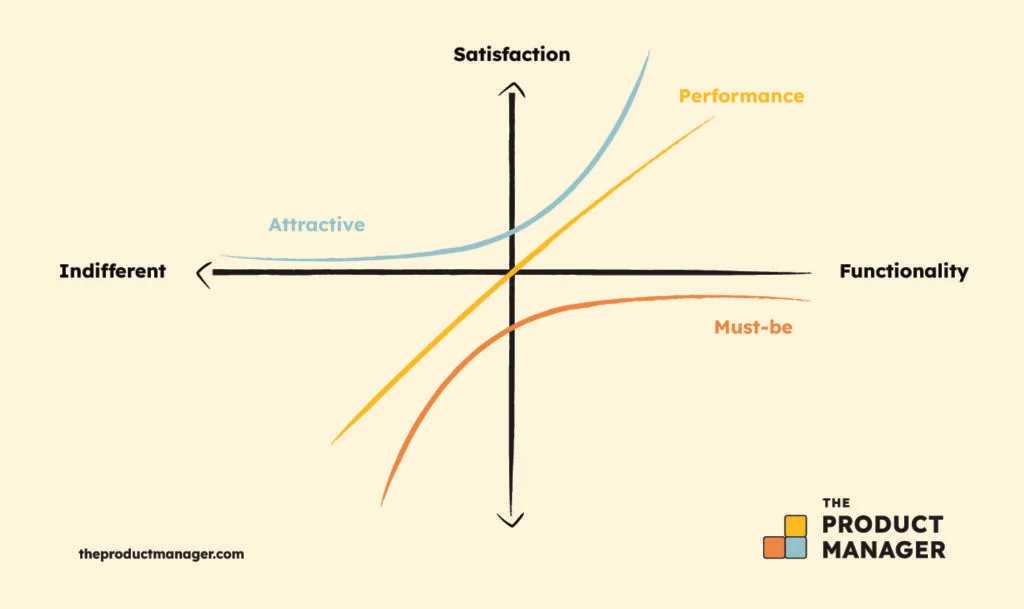
In the example of a hotel, an attractive feature is the cute-looking origami towel, the performance feature is the quality of the mattress, and the must-be is the secure lock on the room entry door.
For your MVP, you focus on the “must-be” features.
MoSCoW: This one’s a simple exercise in which you assign your features “Must-have,” “Should Have,” and “Could have” statuses. Must-haves are the features that cover the core use case.
Using the example of Spotify, a must-have feature is Search. Playlists, on the other hand, are Should Have, and showing album art on the screen is Could Have.
For an MVP, you focus on the Must-haves.
Step 3: Build and test the MVP
Your MVP is not an MVP if you spend too much time building it. So, I suggest taking advantage of the following to speed up your process:
- No-code development: Tools such as Bubble will let you make your first version in a fraction of the time it takes to code from scratch.
- Clickable prototypes: Modern design tools let you make your high-fidelity wireframes interactive - saving time on coding a version of your product.
- Templates and low-code frameworks: Nearly every major cloud provider has ready services that you can use to significantly speed up your development process.
As soon as you have your MVP built, it's time to hand it over to your users. You can use platforms such as AppSumo and Product Hunt to gather your early users and start gathering feedback.
Step 4: Measure success and iterate
One of the core concepts of Lean Startup is measuring the results of your testing with MVP and iterating on it.
Integrating analytics tools such as Mixpanel, Amplitude, and PostHog can help you easily measure your results.
Here are some of the most important product metrics you can measure with these tools.
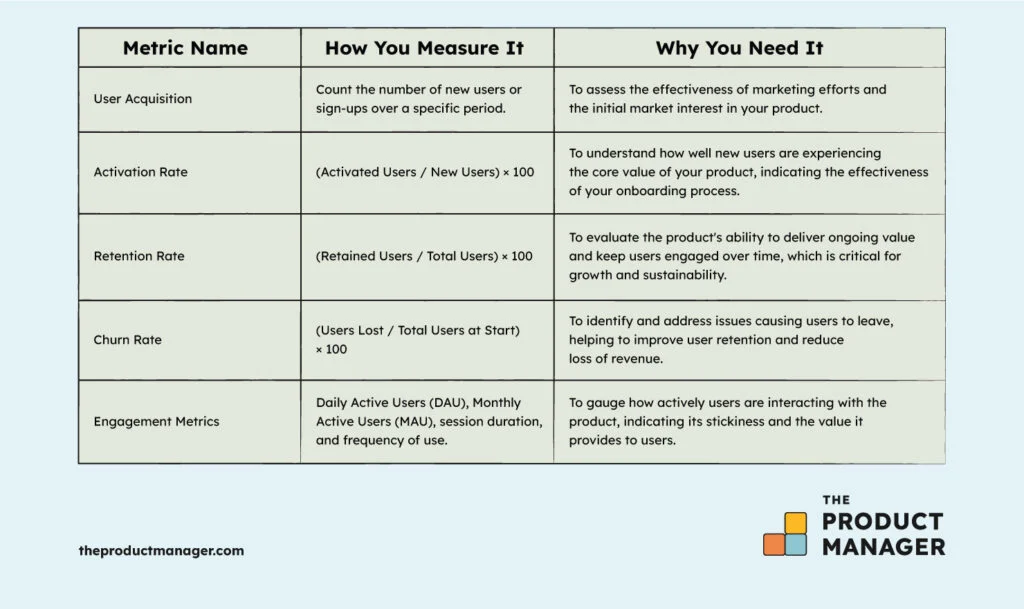
The iteration part is straightforward. You look at the feedback and core metrics to identify areas for improvement, add these improvements to the MVP, and release another version for testing.
My only advice here is to make frequent and small releases. This way, you will understand if your new feature has improved the feedback or your metrics.
Common MVP mistakes to avoid
It’s a bit counterintuitive, but despite the massive popularity of MVPs, people tend to repeat the same mistakes. The main reason behind it is — you guessed it — misinterpreting the core purpose of having an MVP.
To help you avoid these traps, let me point out the three most common ones
1. Over-engineering your MVP version
Many product teams treat the MVP as the version ready to sell, and you can test your product-market fit with it. Not really. There’s a different version of your product for that called MMP (minimum marketable product).
The MVP version, on the other hand, is much smaller and intended to test whether your idea resonates with real users.
2. Ignoring feedback
The user comments and behavior analytics you get from testing your MVP are worth their weight in gold. It is common not to pay attention to some of this feedback, thinking users will still like the final version. No, they won’t! Why even build an MVP version if you refuse to use the lean startup methodology of creating feedback loops?
3. Launching too late or too soon
Both are problematic. If you launch too late, the whole concept of having an MVP loses its meaning. But be careful of launching too soon as well. Your MVP should contain enough features to test your core hypotheses. Your test results will be misleading if you don’t have these features.
4. Confusing MVP with prototypes
These two terms might seem a bit confusing. A prototype is an interactive design that you can use for user testing. While it can technically serve as an MVP, you can also code a lightweight version of your product as an MVP.
Here’s how MVP, Prototypes, and full products differ from each other.
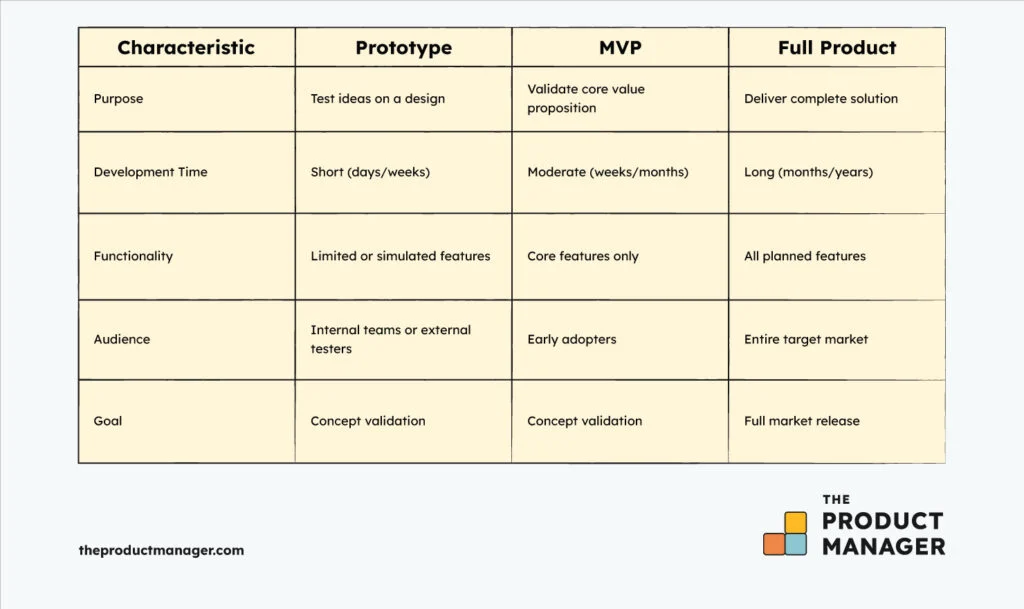
As the infographic above shows, the goal of prototypes matches that of the MVP. The only difference is the physical deliverable for each.
Real-world examples of successful MVPs
I wouldn't be surprised if you're still not sold on the effectiveness of an MVP strategy. Considering there are tons of popular tools and frameworks out there that many people don't find particularly useful, the idea of building a "crappy first draft" of your product doesn't appeal to everyone.
But as a Senior Product Manager who has watched some real trainwrecks happen in slow motion, this is a hill I'll die on. To prove my point, let me show you some examples of MVP products evolving into tech giants.
Dropbox
Remember how I said that MVPs don’t necessarily have to be coded products? Well, Dropbox's MVP version was a video presentation!
In this video, Dropbox’s founder simply shows the concept for a product that did not exist on code yet. The result of this presentation, however, was a massive influx of people signing up to access the product as soon as it was ready. This was the signal for the Dropbox team that they were on the right track.
Airbnb
Our favorite platform responsible for starting housing market crises in many tourist cities (yep, they even banned it in Florence, Italy, for that reason!) also started as a non-traditional MVP.
The company's founders tested the viability of their business model by renting out beds in their apartment in San Francisco to several conference attendees. They wanted to understand if people would be comfortable renting a bed or a room in somebody else’s apartment.
The answer to that question was yes! So, the market gave the founders the green light to start building a platform based on that precise idea.
Zappos
The way Zappos approached its MVP is known in the product world as “Wizard of Oz” testing. In this scenario, you’re building a website for your product, but all the processing on the backend is handled by humans instead of machines.
The Zappos team launched their e-commerce shoe store as a website without back-office processing. When users ordered shoes from them, the team would buy them from somewhere else and ship them to the users. After they received validation from the market that this model works, they started building the back end of their product.
While these three are the most popular stories of MVPs done right, there are many more winning MVPs that have turned into highly successful products.
Tools and resources for building your MVP
The final part of our MVP guide today will be about the selection of product development software and educational materials that can help you improve the efficiency and effectiveness of building an MVP, testing your hypotheses with early adopters, and processing user feedback.
Let’s begin with tools.
- Rapid prototyping and user experience: Figma, InVision, Sketch.
- Workflow management: Jira, Monday.com, Trello.
- Analytics: Mixpanel, Amplitude, PostHog.
- Target audience identification: Reddit, Similarweb.
- Customer feedback processing: Typeform, SurveyMonkey, Google Forms.
And if you haven't read it yet, I highly recommend starting with The Lean Startup as the best resource explaining the MVP approach within the overall structure of build-measure-learn cycles.